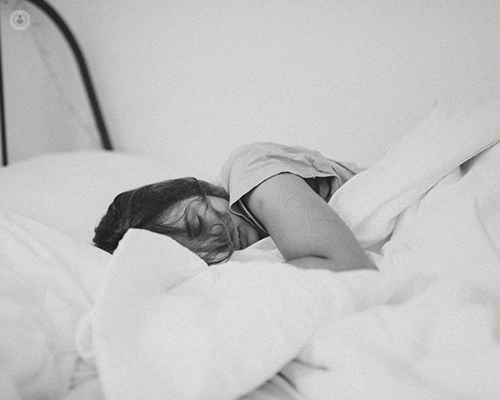Parasomnias explained: what are they and how are they treated?
Written in association with:Parasomnias are unsettling sleep disorders that occur during different stages of the sleep cycle. You may be familiar with the terms sleepwalking, night terrors and/or REM sleep behavioural disorders - Professor Matthew Walker, a leading neurological clinician, is an expert in treating all three of these types of sleep problems. In this article, he explains what they are, why they happen and how they are treated.

What are parasomnias?
Parasomnias are abnormal events or experiences associated with sleep. They can be completely unexpected, unusual and upsetting for the person experiencing them and others close by.
They can be grouped into two categories: rapid eye movement (REM) parasomnias and non-rapid eye movement (NREM) parasomnias.
Dreams tend to occur during rapid eye movement (REM) sleep. As the names suggest, during REM sleep your eyes move very quickly from side to side. REM sleep is part of our sleep cycles, during which brain activity changes during the night.
The importance of the sleep cycle when understanding parasomnias
The two categories (REM and non-REM) occur at different stages of our natural sleep cycle. To understand parasomnias well, it’s very useful to understand these stages.
During a night’s sleep, we cycle between different states. These cycles occur over a 90-minute period and our brains perform this cycle around four to five times in a full night’s sleep. The three stages are light, deep and REM sleep.
1. Light sleep
This is when you start to fall asleep but it’s still easy to wake you. This is the first part of the non-REM phase. A parasomnia is unlikely to occur during this stage.
2. Deep sleep
The first two sleep cycles contain deep sleep. You are, therefore, in this stage mostly in the first third of the night, about one hour after falling asleep. At this stage, you are still in the non-REM phase. This is when we’re most prone to non-REM parasomnias such as sleepwalking and night terrors.
3. REM sleep
REM sleep periods are greatest in the later sleep cycles. You are in this stage mostly in the second half of sleep, towards the morning, unlike the previous two stages in which you’re in the non-REM phase. During this type of sleep, we have our typical dreams. This is when we’re most prone to REM parasomnias such as REM sleep behavioural disorders.
Non-REM parasomnias
Up to 20 per cent of people experience non-REM parasomnias during their childhood. Non-REM parasomnias usually improve by adulthood but still, about four per cent of the population continue to have such events in adulthood. Regardless of age, non-REM parasomnias typically occur once or twice a night. Because they occur during deep sleep, they usually occur within two hours of falling asleep.
Sleepwalking
Sleepwalking is a well-known parasomnia and is a combination of sleep and being awake. After sleepwalking, people can find themselves having cooked, eaten or cleaned and then, in the morning, wake up to find their home a mess.
You can identify a sleepwalker by the following:
- Their eyes are open
- They’re still asleep. They may or may not respond appropriately to you
- They often have no memory in the morning of performing complex activities
- If woken, they are often confused
Night terrors
Night terrors are much more common in children than in adults. Around 80% of sufferers have a family history of it, yet most children grow out of them by adulthood. Night terrors can overlap with sleepwalking and in these cases, people run to try to escape from something; they often look terrified.
You can identify a night terror by the following:
- Their eyes are open
- They’re often still asleep
- They can be inconsolable
- They often have no memory of experiencing a night terror but if woken will describe trying to escape from something or someone
These are not the same as nightmares. Nightmares occur in dream sleep and have a story, whereas night terrors occur in deep sleep and lack a clear recalled story behind the experience.
REM parasomnias
REM parasomnias are much less common than non-REM parasomnias. They affect around only 1 in 200 of the population and are almost exclusive to adults, most of which are over the age of 50.
Usually, our bodies are paralysed during dreams and we don’t act them out. What happens in those with REM sleep behavioural disorders is that the mechanism in our brain that paralyses our body fails. As a result, people can act out their dream in bed. This can be visualised by imagining a person dreaming of running, and thrashing their limbs as if running while still in bed with their eyes closed. More often than not, the dreams are violent.
How are parasomnias caused?
Non-REM parasomnias occur because the part of the brain that deals with fight, flight and fright wakes whilst the parts of the brain that deal with planning, social context and logical thinking are fast asleep. Generally, when adults are sleep deprived, they experience more deep sleep, which results in a higher chance of non-REM parasomnias such as sleepwalking and night terrors.
Also, if people have an internal or external factor that disturbs their sleep, then they are more likely to have non-REM parasomnias. Thus the following are recognised precipitants:
- Sleeping in a noisy area
- Snoring
- Anxiety, which is quite a common cause
- Certain medications or drugs that affect sleep
- Having consumed alcohol before sleep
- Jumping legs – a spontaneous movement of legs during sleep
In some people, REM sleep behavioural disorder may be associated with another neurological condition, in particular, Parkinson’s. This is because neurological diseases that result in the degeneration of parts of the brain can affect the mechanisms that keep our body ‘paralysed’ during dream sleep.
What treatment is available?
Your type of treatment will depend on if you have a REM or non-REM parasomnia.
Non-REM parasomnias
You can lessen the likelihood of sleepwalking and night terrors through both lifestyle changes and medication.
Non-pharmaceutical measures you can take:
- Try to decipher whether anything in particular is triggering these events
- Sleep in a quiet place
- Resolve snoring problems
- Take measures to decrease your level of movement overnight, such leg jerking
- Check if your medication is a trigger of your parasomnia
- Avoid caffeine consumption last thing at night
- Lessen anxiety and stress levels
If your sleepwalking or night terror episodes continue to happen frequently, then certain medications will be suggested. There are two main pharmacological treatments. One is a low dose of antidepressants and these will prevent a part of the brain from waking up. They can also reduce anxiety. The other is clonazepam – a benzodiazepine (like Valium), which is long-acting and stops the brain from waking up.
REM parasomnias
These can be triggered by drugs, and are made worse by consuming caffeine at night. To decrease the chance of REM sleep behaviour disorders, it’s recommended that you do not consume caffeine after four in the afternoon.
Pharmaceutical measures are more effective in treating REM parasomnias:
- Clonazepam (Klonopin) is very effective when treating sleep behavioural disorders. It will lessen the severity of events
- You can take high doses of melatonin – melatonin is a naturally occurring substance that we secrete in the brain and it regulates our sleep. It’s used a lot in the treatments of jet lag and it can stop the REM sleep behavioural disorder from occurring.
Often, specialists invite sufferers of sleep behaviour disorders to hospital and record their sleep overnight. This way, they can confirm the diagnosis and see if there is anything else that’s disturbing the patient’s sleep. If other disturbances are found, they will need to be treated. Additionally, sometimes specialists are concerned if an episode of abnormal sleep behaviour is due to an epileptic seizure. If this is a possibility, it will be thoroughly investigated.
Professor Matthew Walker is an expert in various fields of neurology, including sleep disorders. View his Top Doctors profile to learn more and to book a consultation.


